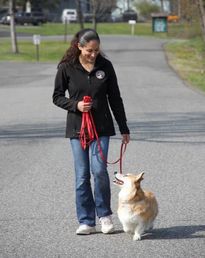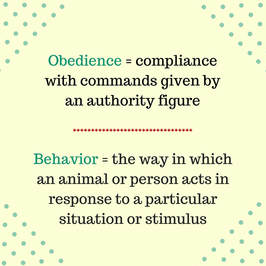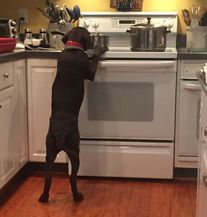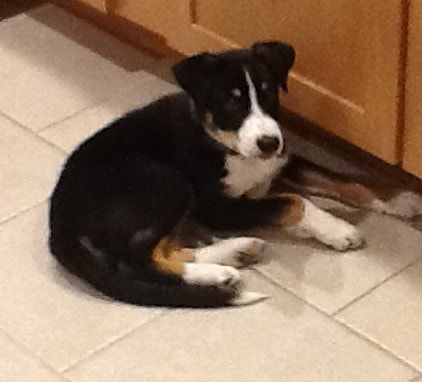Behavior is a Lifestyle - Building Your Dog's "New Normal"
Since we are all individuals, we all have slightly different lifestyles. As a result of living with us, so do our dogs – especially since they are individuals too. But even with our little nuances, most of us humans still have some of the same general lifestyle rules – i.e. say “please” and “thank you”, wait your turn in line, respect your elders, and whatever other “lifestyle values” you do your best to uphold. Many of those lifestyle values are formed as we grow up, by our parents and family, friends and other role models in society that we aspire to be like. It then becomes our “normal” way of life and makes us who we are. Well, building good behavior in your dog is pretty much the same thing!
|
As pups grow, they are learning and forming associations that are going to shape them into the adult dogs they will become. Like us humans, dogs need good leadership to teach them the ways of life, manners, and how they are expected to behave. While some behaviors, like bite inhibition, are learned mostly while young pups are still with their moms, a large part of our dogs’ behavior is learned after they leave their moms and enter life as our companions. So it is up to us to provide our dogs with the guidance they need to become well-behaved adults. Behavior is a lifestyle - it goes deeper than a dog who just depends on performing obedience commands when directed; it's about your dog making good choices and knowing how to behave in everyday, real-life situations.
|
Building The "New Normal"
It’s important to make training flow in part of your normal everyday lifestyle so it doesn't really feel like "training" to your dog, or to you – it just becomes the "new normal.”
Let’s take a human example: You wouldn’t teach your child manners only some of the time, and you also don’t set up “training sessions” where that’s the only time you practice manners, right? Instead, you teach your child how to eat politely (and not throw food) anytime your child is eating – whether it’s in your kitchen, at a family party, in a restaurant, or with friends. You teach your child that anytime someone gives you a compliment or does something nice for you, you say “thank you.” This allows the child to learn consistently what it means to have good manners and it just becomes a way of life.
It’s important to make training flow in part of your normal everyday lifestyle so it doesn't really feel like "training" to your dog, or to you – it just becomes the "new normal.”
Let’s take a human example: You wouldn’t teach your child manners only some of the time, and you also don’t set up “training sessions” where that’s the only time you practice manners, right? Instead, you teach your child how to eat politely (and not throw food) anytime your child is eating – whether it’s in your kitchen, at a family party, in a restaurant, or with friends. You teach your child that anytime someone gives you a compliment or does something nice for you, you say “thank you.” This allows the child to learn consistently what it means to have good manners and it just becomes a way of life.
|
Now let’s apply that same idea to a dog scenario: You want to enjoy walks with your dog. If you want your dog to respect you and the leash (and not pull you down the sidewalk), you should practice leash manners every time your dog is on leash. This results in clear expectations that your dog can understand and a greater chance at building good solid loose leash-walking behavior. If you only sometimes work on good leash manners and other times let your dog pull you like he’s in the Iditarod, that inconsistency is going to confuse your dog about your expectations and you will keep dealing with this problem for a long time to come. But instead, with consistent practice walking on a loose leash, this will become second nature to your dog. Then neither of you will have to think about it – you’ll just both be able to enjoy a good walk together!
|
Anxious, Hyperactive or Excitable Dogs
Some dogs naturally learn how to deal with their emotions in a productive way (by making choices and realizing that they are rewarding – such as deciding to chew on a bone to release emotional energy). Yet others need to be taught how to handle this emotional energy through our guidance in order to build a more relaxed lifestyle.
Typically, if a dog is highly anxious or excitable, it’s a result of the energy he is getting from his environment, a lack of confidence or impulse control, or a lack of understanding of the boundaries or expectations (which means we may have to re-evaluate the kind of leadership he is getting). To decrease anxiety or excitability, it involves plenty of teaching opportunities through repetition and practice in small slices to shift this dog’s behavior into a lifestyle that involves more self-control, confidence, and the ability to spend much more time in a calmer emotional state than in a state of high arousal. This lifestyle change does not come from focused training sessions in 30 minutes each evening; it comes from real-life application that is practiced throughout the day whenever the opportunity presents itself – to create the “new normal” way of life.
Some dogs naturally learn how to deal with their emotions in a productive way (by making choices and realizing that they are rewarding – such as deciding to chew on a bone to release emotional energy). Yet others need to be taught how to handle this emotional energy through our guidance in order to build a more relaxed lifestyle.
Typically, if a dog is highly anxious or excitable, it’s a result of the energy he is getting from his environment, a lack of confidence or impulse control, or a lack of understanding of the boundaries or expectations (which means we may have to re-evaluate the kind of leadership he is getting). To decrease anxiety or excitability, it involves plenty of teaching opportunities through repetition and practice in small slices to shift this dog’s behavior into a lifestyle that involves more self-control, confidence, and the ability to spend much more time in a calmer emotional state than in a state of high arousal. This lifestyle change does not come from focused training sessions in 30 minutes each evening; it comes from real-life application that is practiced throughout the day whenever the opportunity presents itself – to create the “new normal” way of life.
How Having Obedience Skills Can Lead to Good Behavior
It’s very common that we take our dogs to obedience classes as a young pup – to socialize with other pups and learn how to sit, down, stay, come, etc. But often times, when obedience classes are done, we get complacent and don’t take the next step to go beyond obedience to build long-lasting behavior and help our dogs learn to cope with things that are stressful, exciting, scary, frustrating, etc. This is usually where, later on own the line, behavior problems develop.
It’s very common that we take our dogs to obedience classes as a young pup – to socialize with other pups and learn how to sit, down, stay, come, etc. But often times, when obedience classes are done, we get complacent and don’t take the next step to go beyond obedience to build long-lasting behavior and help our dogs learn to cope with things that are stressful, exciting, scary, frustrating, etc. This is usually where, later on own the line, behavior problems develop.
|
Obedience training is important because it gives you a set of skills you can use to direct your dog, but you must go deeper than simple obedience training to build good behavior and teach your dog how to handle life’s situations. I often use the following analogy to put this in perspective… Obedience is like knowing the alphabet – you can sing the song from A to Z, but that’s all it is by itself. In order to function more appropriately in society, we must go beyond knowing our ABC’s to understand how to spell words, write sentences, and communicate more effectively – this is like behavior.
With this in mind, it can be easier to see how you can have a dog who has learned specific commands and will perform them when asked (obedient), but not a well-mannered (well-behaved) dog if he hasn't been shaped and molded the right way. A big part of this shaping of behavior includes setting up parameters for your dog to succeed but giving him the ability to think for himself within these parameters to make good choices. Understanding how your dog’s brain works and what his needs are - and meeting these needs – is an important key in shaping both an obedient AND well-behaved friend. |
Dogs can do amazing things (like guide the blind and detect seizures before they occur), but they have a more difficult time than humans when it comes to generalizing and understanding concepts (and they can’t read our minds!). So unless they are given the opportunity to figure it out for themselves (with us there to coach them and control the circumstances, not the dog), your dog may only understand how to respond to obedience commands when you are managing him but not understand how to control his emotional and mental responses that dictate his behavior in a more productive way on his own.
Let’s take a look at a common obedience faux pas… Have you ever had your dog be a rock star at “sit” in your living room but when you get him in obedience class, at your sister’s house, in the park, or if the kids are running around with water guns he just can’t seem to maintain any self-control and his knowledge of “sit” goes right out the window? This could be because he hasn’t practiced in enough situations yet to make this a truly solid skill, or because the level of stimulation surrounding him is causing a high level of arousal and he’s not in a calm enough emotional state where he can think, learn, and make good choices. If he can’t think to respond to obedience commands in these kinds of higher stimulation situations, it’s very unlikely he’ll be able to make good choices about how to behave in these situations either.
Let’s take a look at a common obedience faux pas… Have you ever had your dog be a rock star at “sit” in your living room but when you get him in obedience class, at your sister’s house, in the park, or if the kids are running around with water guns he just can’t seem to maintain any self-control and his knowledge of “sit” goes right out the window? This could be because he hasn’t practiced in enough situations yet to make this a truly solid skill, or because the level of stimulation surrounding him is causing a high level of arousal and he’s not in a calm enough emotional state where he can think, learn, and make good choices. If he can’t think to respond to obedience commands in these kinds of higher stimulation situations, it’s very unlikely he’ll be able to make good choices about how to behave in these situations either.
In order for a dog to really learn a skill (to the point where it becomes ingrained in his mind and easy for him to perform in any situation), he must practice that skill over and over again in a variety of different environments, situations, and with varying degrees of distraction, distance and duration. When we have those skills burned into your dog’s “skill library”, you can utilize them to build good behavior. He will likely need us to coach him to perform these skills in these situations at first, but the more and more he practices, the more these skills lead to good decisions that just become second nature to the dog – and that’s where you build good behavior.
|
Bridging the "Obedience to Behavior Gap"
Let’s say your dog is a frequent counter-surfer and has a tendency to eat everything and anything left on your kitchen counters unattended. Rather than focusing on punishment to correct this behavior, let’s focus on teaching your dog a better way to handle this scenario… First step: Set Clear parameters. Remove all items from the counter so your dog does not have access to these items without your supervision (if you are trying to build good behavior but he has the opportunity to reward himself by jumping on the counter when you are not there, you are completely working against yourself and confusing him about the boundaries). If there’s never any reinforcement for jumping on the counters, this behavior can be easily extinguished. But if he tries and gets a reward occasionally, it’ll be like playing the lottery to him – he’ll just keep counter-surfing, knowing that one day he may hit the jackpot! |
|
Next: Tell your dog what you want him to do in the presence of the counter. How about laying down? When you are giving him access to the counters (under your supervision), be proactive and ask him to lay down in the kitchen before he tries to jumpup on the counter. Then praise and reward him for laying down. What if you make yourself a snack? Continue to praise and reward your dog for remaining in a down near the counter while you prepare your snack. If you miss the opportunity and he jumps up, immediately direct him into a down again, wait a few seconds, and then reinforce (so he doesn’t get rewarded for jumping then laying down) – and adjust your timing to interrupt any jumping before it occurs. If you step away from him (even for a second) and he still remains laying down (rather than attempting to jump), give him double the praise and reward.
|
Upon repeated practices, gradually provide less direction – basically, you are testing how much your dog has learned. Dogs easily pick up on patterns, so if you have consistently asked him to lay down when he is in the kitchen, he may anticipate that you will ask him to lay down again. When he goes ahead and makes the choice to down on his own before you ask him, give him the proper recognition so he understands how awesome his choice is. He’ll feel like a genius and will want to keep making this choice! Gradually add in more distance between the two of you until you can trust him to consistently make the right choice with you anywhere in the room, then without you in the room. If there’s ever anything tempting on the counter and he still makes the choice to lay down on his own rather than jumping up, give him the biggest bonus payday he deserves!
This is how you build good behavior. Your dog’s new conditioned response will become to lay down in the kitchen rather than trying to rummage the counters for freebies!
Remember, our dogs are thinking, processing, learning and making choices all throughout the day (just like we are). The question just becomes: are they learning what WE want them to learn, or are they learning something else (maybe something we DON'T want)? The beauty of it is, we have the ability to teach our dogs whatever we want their "new normal" to look like! We just have to know what we want and take the steps to get there - by practicing consistently in real-life situations (not just training sessions), and providing clear direction and feedback throughout the process.
For support in your process to building a good lifestyle for your dog - a "new normal" that includes manners, confidence, self-control, and more - contact Maria directly at (845) 549-0896 or [email protected].
This is how you build good behavior. Your dog’s new conditioned response will become to lay down in the kitchen rather than trying to rummage the counters for freebies!
Remember, our dogs are thinking, processing, learning and making choices all throughout the day (just like we are). The question just becomes: are they learning what WE want them to learn, or are they learning something else (maybe something we DON'T want)? The beauty of it is, we have the ability to teach our dogs whatever we want their "new normal" to look like! We just have to know what we want and take the steps to get there - by practicing consistently in real-life situations (not just training sessions), and providing clear direction and feedback throughout the process.
For support in your process to building a good lifestyle for your dog - a "new normal" that includes manners, confidence, self-control, and more - contact Maria directly at (845) 549-0896 or [email protected].
Written by Maria Huntoon, Maria G. Huntoon Canine Consulting Services











